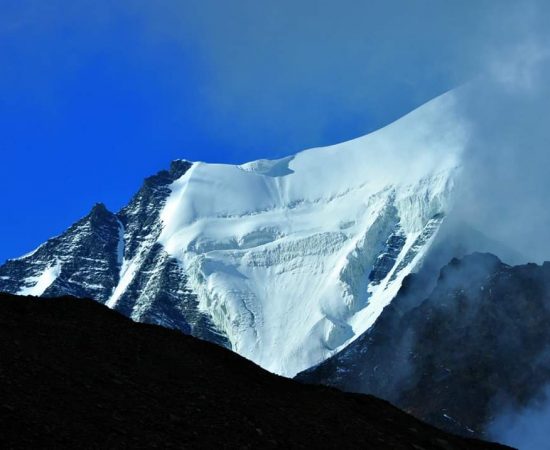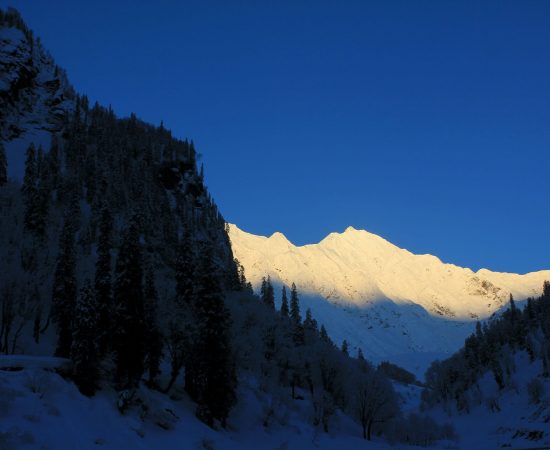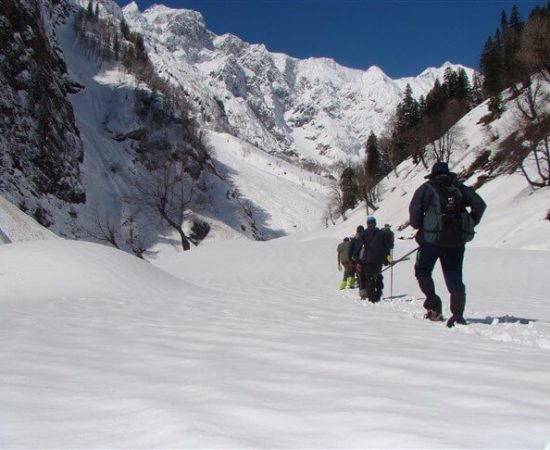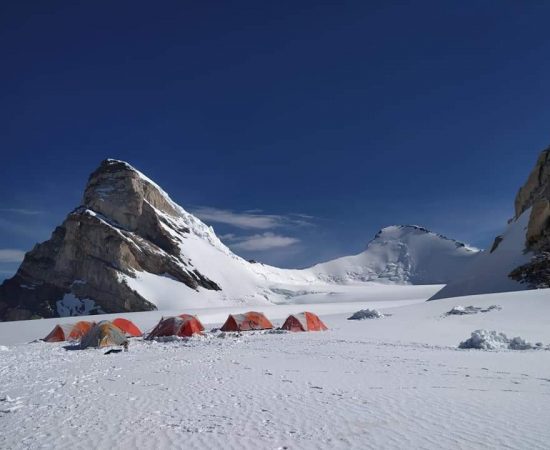Mount CB-13 14 Expedition
Lahaul, Himachal
Rated 4.9/5.0 on TripAdvisor. 550 Reviews


Key Highlights
- Altitude : 6254mtr/20550Ft
- Time : 20 Days - 19 Nights
- Region: Lahual
- Best Time: May-September
- Grade: Difficult
Overview
Mount CB-13 14 Expedition
Known as "CB13," or the "Chandrabhaga 13," The summit is situated in the middle of the Lahaul Massif, and it provides a breathtaking panorama of the Kunzum Range, Chandratal Lake, and the Dhaka Glacier. They are two of the most famous and picturesque mountains in the Indian state of Himachal Pradesh. The CB 13 is one of the most alluring peaks in the Himalayas, evoking images of the uncharted and inaccessible valley of the Hindustan-Tibet Road and the serenity of Chandratal lake. One can become ready to climb the twin peak with previous expertise of nontechnical peak climbing and a solid understanding of mountaineering. CB 13 and CB 14 are on the more challenging end of the spectrum because of the rouged landscape, tricky stones on route, and the steep peak.
The CB13 peak stands at an elevation of 6,264 meters, while the CB14 peak is slightly lower at 6,078 meters. Both of these peaks are located in the Bhaga valley of Lahaul, and offer breathtaking panoramic views of the surrounding landscape. The peaks are accessible only during the summer months, from June to September, when the weather is relatively mild and the snow has melted enough to make climbing possible.
Read More
The expedition begins from the lush green valley in Manali, which is the starting point for many expeditions and treks in the region making it an Adventure hub attracting thrill seekers from all around the world. From Manali, participants make their way to the Rohtang Pass, which is situated at an altitude of 3,978 meters. From here, the trail descends into the Bhaga valley, where the CB13 and CB14 peaks are located. As trekkers make their way towards the peaks, they pass through some of the most beautiful valleys and meadows in the region. The Bhaga valley is home to a variety of flora and fauna, including rare species of birds and animals. Trekkers are often treated to sightings of Himalayan ibex, snow leopards, and musk deer, among other species.
Cost Per Person
Key Highlights
- Altitude : 6254mtr/20550Ft
- Time : 20 Days - 19 Nights
- Region: Lahual
- Best Time: May-September
- Grade: Difficult
Complete
Itinerary of Expedition
Welcome to India, a region where warmth and generosity are second nature, to a culture rich in history and whose heritage continues to be expressed through art forms such as music and dance. We will have a representative meet you at the airport and take you to your hotel.
Stop by the Indian Mountaineering Foundation (IMF) later in the day to meet with a Liaison Officer and the foundation's director for a briefing and approval. Spend the night in Delhi
TRAVEL TIME: 13 HOURS / 570 KILOMETERS
After taking care of all formalities required for our expedition at IMF we will leave for Manali in the evening so if you want to take care of some last minute purchases then you can stock up at any Decathlon store in Delhi. In the evening we will depart for Manali, it takes around 12 hours to complete the 570 km journey. We will book a Volvo bus or any other mode of transport depending upon the group size. You will reach Manali the next morning.
On reaching Manali, you will check in to your hotel and get some time freshen up after a long journey from the capital. The better half of the day will be spent in Manali’s municipal offices to get permits for the expedition. Sensitive areas require permits for access. Soon after you will be briefed about the CB13 & 14 Expedition by our Expedition Leader. A trip to the Hadimba Devi temple (this temple was built in 1553 and is dedicated to Goddess Hadimba) awaits. The temple's beautiful wooden carvings show legendary figures, themes, and even cosmic dancers. Then there's Old Manali and the Mall road (where you can go for shopping & Eating), Hotel for the night in Manali.
After having breakfast at our hotel we will board our vehicle which will take us to Batal. Our goal is to leave as early as possible so that unwanted traffic can be avoided in 6 hour journey to Batal. Earlier travellers used to take the route from Rohtang pass but with the opening of the Atal Tunnel we will reduce the time it takes to climb up to the pass and then descend down to Lahaul district. Batal is a small settlement in Lahaul district and the route is simply breathtaking with narrow roads where only one vehicle can pass to immaculate views the region poses. Our drive starts from Manali which is situated in a lush green valley and as we enter Lahaun the whole landscape changes to semi arid mountains with enormous glaciers on top of them. After reaching Batal we will check in to our Homestay/ Guest House where we will spend the night.
Today for our acclimatization day we will explore Chandratal Lake, which is a beautiful alpine lake situated at an altitude of 4100 meters above sea level. The name Chandrataal comes from the shape of this lake. “Chandra '' which translates to moon and “Taal” translates to lake gives moon shaped lake its name. As you approach the lake there is almost little to no vegetation and a feeling that you are walking on Mars. The rocky terrain with different shades of brown, gray and white. The lake is a tourist attraction so many tourists can be found during the summer months. After our visit to the lake we will return to our homestay at Batal.
From today we will begin our journey on foot and the true sense of the expedition begins from here. The trail to the base camp is completely rocky and one has to be very careful not to twist their ankle during their trek to the base camp. The initial part of the trail starts with a gradual climb so that we can gain some altitude from Batal and we can be comfortable on the route. After gaining altitude we will traverse along the mountain with the Chenab river on the other side flowing right next to us. We carefully administer each step and keep moving forward. It's important to keep in mind that today is a long day and we would be gaining an altitude of 450 meters approximately. Drinking water while ascending is the most important step for acclimatization. For the last stretch of today's trail we divert away from Chenab river and head inside the rocky lands. After reaching the base camp we will pitch our own tents where we will spend the night.
Like in the case of treks we provide you with a fixed itinerary with rigid day to day plans which we strictly follow but in the case of an expedition the circumstances can’t always stay the same and we might have to alter or edit the procedure through which we will be making our summit attempt. We shall use the familiar acclimatization methods and rotating camps along the way as we gain altitude. An estimated timeline can be framed for a successful summit.
Base Camp to Advance Base Camp: Load Ferry and Occupation
The terrain will get more extreme from here onwards, from just rocky terrain we will now experience glacial terrain, i.e., we will get a mix of hard ice mixed with rocks which are called moraine. A mix of these two features makes it even more challenging as one has to change their method of walking to adjust. Mules are only accessible till the base camp, from there onwards it is all us who have to carry the burden and that includes ration, sleeping bags, tents, butane cans for cooking, etc. So we will divide the load with everyone so that every single individual plays a part in the load ferry process and the expedition can run smoothly. During our first trip to ABC we will carry the majority of the load and set up a few camps where we can carefully store our goods. On our first trip we will just keep our stuff and come back down to the base camp for the night. On our second trip to the ABC we will pack whatever necessities that are left to carry to the ABC and then we go and pitch all the tents required so that we can occupy and establish our ABC at an altitude of 4900 meters approximately.
Advance Base Camp to Summit Camp
Like the occupation of the previous campsite, we will occupy this one in two stages as well. The route from the ABC to the summit camp is not too long but the conditions and treacherous terrain make it a long and exhausting journey. The route switches between rock and ice and the climb is also steep so careful navigation needs to be conducted for climbing. At a point in between there is a huge snow field where you remain the remnants of a plane crash of the Indian Army which happened in 1968. The scattered pieces and debris of the crash sends a sense of awe and terror to imagine what had actually happened and that the debris could never be cleared due to hostile conditions. Hidden crevasses and steep slopes are very common here onwards. Fixed ropes need to be applied so that the team can carefully Jumar their way up to the summit camp.
Summit Attempt
The summit attempt starts late at night usually between 12 am to 1 am and we gain an altitude of approximately 650 meters. This is probably the hardest day of the expedition with bone chilling winds and it takes upto 8-10 hours for the ascent depending upon the speed of the group. Fixed ropes are fixed by the guides for safer climbing conditions. Amazing view of Lahaul valley and Bara Shigri glacier from the top of the summit. Climb back down to summit camp after a successful summit.
Summit Camp to Advance Base Camp
We will wind up all the tents and equipment that we used during the expedition and head back down to the base camp. Make sure to bring back all the waste generated during the journey. Few alterations might be made if we take a stop at the ABC for one night before reaching the base camp.
Advance Base Camp to CB14
The ascent to CB14 depends on the weather and snow conditions. The climb to the summit of Cb14 is slightly less technical and fixed ropes might not be used.
Reserve Days
Wekeep two days as reserve days so that they can be used in case of bad weather.
You may have a leisurely breakfast and then continue your journey back to Batal. Tent camping for the night in Batal.
Food:- Breakfast, Lunch, and Dinner
In the morning, after breakfast, you'll go back to Manali. Arrive at Manali, India, and spend the night in a comfortable hotel room.
Meals: Breakfast, Lunch, and Dinner
DAY 20: Leave DELHI
After a hearty breakfast, you and your travelling companions will be transferred to the airport for your international departure.
The Morning Meal is served only.
Enquiry For Group Bookings
Guidelines
➽ Preparation for Expedition
As you well know, the great Himalayan expedition is one that requires careful preparation, a strategy that allows for enough flexibility to adapt to whatever challenges may arise.
Therefore, here are some things to consider before setting out on your CB- 13 14 Expedition:
⦿ Physically – You should start working out at least a month before signing up for a program if you want to be physically prepared for the rigours of a journey. Strengthen your legs by jogging and working out regularly to increase your stamina. To better acclimatise to the environment and increase your resilience on the walk, you should give up smoking and undertake breathing exercises twice a day. Engage in vigorous physical activity, such as playing sports, doing Yoga, or running.
⦿ Mentally –
Getting in shape physically is essential, but mental preparation is just as crucial for a successful walk. Take time to enjoy your regular activities, maintain a healthy diet and sleep schedule, and unwind before embarking on a hike. Predictions regarding the journey should not cause mental worry. Spend time with your closest pals to recharge your batteries and renew your spirit. Pre-trek preconceptions are unwarranted since the first contact with the other trekkers is certain to be a source of inspiration and energy. Conditions during the walk will contribute to the increase in mental readiness. The mental repercussions of physical disadvantages will not be ignored. So, when you hike, pay attention to different regions of your body and purposefully relax them. If you want to enjoy your hike, you should learn to loosen up a little, particularly in the hips. Think about your descent as a simple dance, and enjoy the natural rhythms that the path and your body can discover together gradually, whether you're on a flowing downhill route or a frightening slope. Try out a few new walking techniques to add some fun to your commute without worrying about getting somewhere in particular. Maintaining mental fitness mostly requires a willingness to relax and take in the journey, rather than subjecting oneself to undue stress.
Guidelines
➽ How to Reach
How to reach Manali:
Delhi and Manali are linked nicely. You may travel from Delhi to Manali in 12 to 14 hours via overnight bus (approx 540 KMS). Online ticket reservations are available at www.redbus.in and www.hrtc.gov.in Tip: Given the distance between Delhi and Manali, the majority of Volvo private buses depart Delhi between 5 and 8 p.m. At 8.30 p.m., the final government bus departs from ISBT Kashmere Gate. Between Rs. 1,200 and Rs. 1,800 are charged by Volvo buses each sector from Delhi to Manali and vice versa. Delhi to Manali: Buses depart from Manali for Delhi between 4 and 8 p.m., same like the return trip. You should expect to arrive in Delhi any time between six and ten in the morning. Plan your subsequent trips just after midday, leaving ample time for bus delays.
How to reach Naggar:
Naggar is 18 kilometres from Manali, and there are several buses that operate every 15 minutes. Alternatively, one may get out at Patlikuhal, which is 5 kilometres from Naggar on the right bank highway. Between Kullu and Manali is Patlikuhal. To get to Naggar, you may take a cab or a local bus from Manali or Patlikuhal.
The closest train station is:
Ambala (350 miles) and Chandigarh are the closest railway stations (310 kms). Advice: From Chandigarh to Manali, regular buses and Volvos run in the evening. Volvo buses from Chandigarh to Manali and vice versa charge between Rs. 800 and Rs. 1,200 every sector.
The closest airport:
The closest airport to Manali is Bhuntar, which is 52 kilometres distant. From Bhuntar to Manali, taxi services are available and cost between Rs. 1500 and Rs. 2,500. Air travel between Bhuntar and Delhi is convenient. Airlines providing flights from Delhi and Chandigarh to Kullu include Indian Airlines, Kingfisher Airlines, MDLR Airlines, and Jagson Airlines.
Guidelines
➽ Things to Carry
- Good Trekking Boots: You need sturdy trekking boots with supportive high ankles. Don't bring your running shoes. U can carry extra floaters/flip flops also.
- Wear warm clothing, such three-layer coats, fleece upper, hollow fill or down-filled jackets. Carry full-sleeved T-shirt. Carry cotton hiking trek pants and warm pant for your lower body. Never bring shorts or jeans on a hike.
- Take top and bottom thermals with you.
- Quick dry towel with light weight and Personal toiletries. Suns cream lotion, sanitizer, tooth brush ad toothpaste, lip balm and antibacterial powder.
- Socks: Bring two pairs of regular socks and two pair of wool socks for wearing at night.
- A head torch is required.
- Sunglasses/ Goggle: UV-protected sunglasses are necessary to protect against sunlight and Snow Mountain.
- There should also be a woolen cap / balaclava, cap, neck gaiter cum face mask and warm fleece and waterproof summit gloves since it will be chilly. Keep waterproof gloves on hand since they become wet in the snow.
- Everyone taking part in the activity should have their own lunchbox, spoon, mug and water bottle/ hydration pack of 2 ltr.
- Raincoats/ponchos: Since snowfall and rain are frequent at high elevations, it is important to have one on hand so as to avoid getting wet.
- Trekking bag of 75 ltr with rain cover.
- Walking stick.
- Personal first aid box. Emergency ration, energy bars, dry fruit, electoral/Ors
- Personal technical gears list of mountaineering (on rent basis available)
- Climbing boot, Crampon, Sleeping bag (optional), Ice axe, seat harness, Rope and tape sling, helmet, Summit gloves, Gaiters, Carabineers 2 no (screw), figure of eight/descendor, Zumar (Ascendor),
- Required Documents:
a) Registration Form
b) Medical Certificate (signed by a licensed MBBS physician)
c) NOC form (completed by the trekker)
d) 2 passport-size photos
e) ID Proof photo (not PAN)
f) Basic Mountaineering Course certificate.
g) Insurance upto 5 lac..
➽ Trip Cost Includes
- Mountaineering (Instructor/guide) services provided by a highly trained, professional, and qualified Himalayan Adventure Trips staff.
- Certified local guide with extensive familiarity of the area.
- Climbing provides only vegetarian food (breakfast, lunch, and dinner).
- Staff include chefs, cooks, and helpers.
- High Altitude Force, Low Altitude Force, Porters, Mules for Common Equipment (Rations, Tents, Utensils, Central Climbing Equipment, etc.)
- Tents (to be shared), sleeping bags, air mattresses, and air pads are included. Inner
- We offer twin-share accommodations in dome, alpine, and high-altitude tents on all of our treks and expeditions. All necessary camping equipment, including air mattresses, a shelter for cooking and eating, a table and chairs, a stool, and more, would be supplied.
- Someone who can carry heavy items, set up high camps, repair ropes, etc. at high altitudes.
- Assistance from Guide All the Way to the Top
- High-altitude butane gas cooker
- The only meal offered at the hotel will be breakfast. All meals while on the walk will be supplied for you. Indian, Chinese, and Continental cuisines, all freshly cooked, will be on the menu.
- Tin-packaged food is what we'll eat at high altitude.
- A standard first aid kit with oxygen masks for the patient.
- Camping fees, wildlife fees, and forest permits.
- Taxes imposed by the state.
➽ Trip cost Excludes
- Climbers may hire individual porters to carry their gear.
- Airport transportation costs
- Expenses for carrying still/video cameras etc.
- Irregular/Personal costs, such as laundry, phone calls, and gratuities.
- Climbing equipment such as ropes, pitons, snow bars, crabs, etc.
- Your own personal mountaineering equipment and clothes, as well as any specialised foods you may need
- Inner Line Permit.
- Health coverage or the price of a rescue mission
- Expenditures of a more personal character (such as booze, soda, bottled water, mineral water, canned or bottled drinks, candy, canned or packaged dried fruits, etc.)
- Provisions/food to or from the starting point of the trek.
- Any expenses that are incurred as a result of natural disasters, human error, or other unforeseeable occurrences.
- Protect your trip with a travel insurance policy.
- Authorization, licensing, and enlistment with the IMF.
- Payment for Liaison Officer (included for foreign expedition only)
- GST of 5%.
Guidelines
➽ Special Casual Leaves
Government employee can avail the benefit of special casual leave when u join us for a trekking expedition. As per the rule of the pay commission, special casual leave can be availed for up to 30 days in a calendar years for trekking and mountaineering expeditions through a register organization. Himalayan adventure trips are a register adventure tour operator register with Indian mountaineering foundation and Himachal Pradesh tourism. Candidates have to apply for leave at least 30 days before the trek/expedition start.
Testimonials
➽ Provided By The Customers
Everything about our visit to Prashar lake was better than we could have imagined. From our initial contact with Himalayan Adventure Trips, we felt their genuine interest in learning about our group's goals and expectations, and our travels with them reinforced at every turn that they not only understood our requirements but also have the acute skill and expertise to achieve them. Having already had such a wonderful experience with this firm, I will be promoting a trek to Prashar lake to all my friends who share my passion for hiking and will specifically recommend that they work with this outfit. Absolutely fantastic; I have nothing but praise for it.
How useful was this post?
Click on a star to rate it!
Average rating 5 / 5. Vote count: 1
No votes so far! Be the first to rate this post.







This Post Has One Comment
We completed the CB 13 Peak climbing expedition and it was an unforgettable experience. The climb was challenging but incredibly rewarding, with stunning views of the surrounding mountains at every turn. Our guide was knowledgeable and supportive throughout the journey, making sure we were safe and well-prepared for each stage of the climb.
While there were certainly some difficult moments, such as navigating the steep terrain and dealing with the occasional snowstorm, the feeling of accomplishment upon reaching the summit was absolutely worth it. I also enjoyed meeting and bonding with my fellow climbers along the way, sharing stories and tips as we made our way up the mountain.
Overall, I would highly recommend the CB 13 Peak climbing expedition to anyone looking for a challenging and rewarding climb. Just be sure to bring your sense of adventure and a strong determination to succeed!